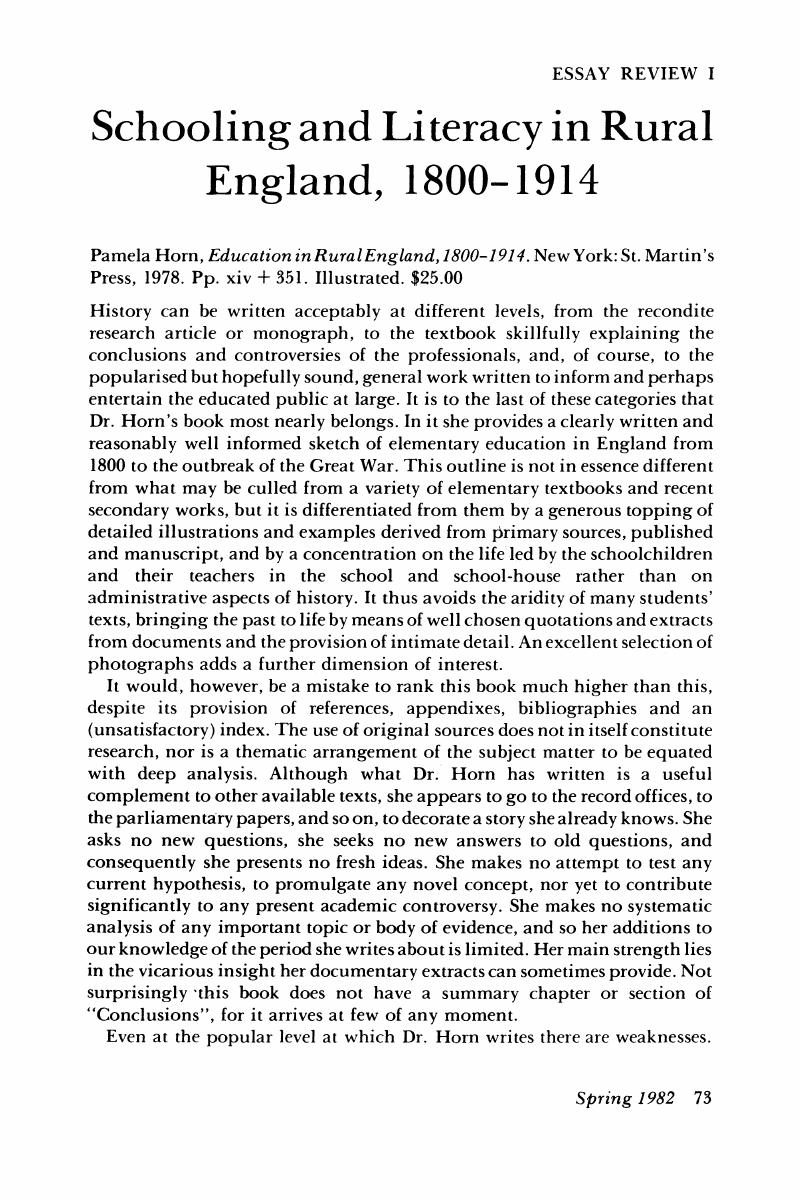No CrossRef data available.
Article contents
Schooling and Literacy in Rural England, 1800–1914
Published online by Cambridge University Press: 24 February 2017
Abstract

- Type
- Essay Reviews
- Information
- Copyright
- Copyright © 1982 by History of Education Society
References
Notes
1. Cf. Mills, D. R. “How do we Define Rural Communities?“ in Mills, D. R. (ed.), English Rural Communities (London, 1973), pp. 12–17.Google Scholar
2. Laqueur, T. W. Religion and Respectability: Sunday Schools and Working Class Culture, 1780–1850 (London and New Haven, 1976), p. 53.Google Scholar
3. Tompson, R. S. Classics or Charity? The Dilemma of the Eighteenth Century Grammar School (Manchester, 1971); Sanderson, M. “The Grammar School and the Education of the Poor,” British Journal of Educational Studies, 11 (1962–3).Google Scholar
4. Simon, J. “Was there a Charity School Movement?“ in (ed.), B. Simon Education in Leicestershire, 1540–1940 (Leicester, 1968); Sanderson, M. review in Economic History Review, 2nd series, 22 (1969): 345–6.Google Scholar
5. See Lawson, J. Primary Education in East Yorkshire, 1560–1902, East Yorkshire Local History Series, 10 (York, 1959), p. 5, 10; Baker, W. P. Parish Registers and Illiteracy in East Yorkshire, East Yorkshire Local History Series, 13 (York, 1961); Wilson, R. “Schools in Yorkshire, 1700–1750,” (University of Hull, unpublished M.Ed. thesis, 1977), p. 96, 113.Google Scholar
6. Report of the Royal Commission on the State of Popular Education in England, British Parliamentary Papers, (1861), 48 vol. i, 595.Google Scholar
7. Mann, H. “The Resources of Popular Education,“ Journal of the Statistical Society of London (1862). Cf. Report of the Royal Commission on Popular Education, i, 636.Google Scholar
8. Census of Great Britain, 1851. Education, England and Wales (1854).Google Scholar
9. Stephens, W. B. Regional Variations in Education during the Industrial Revolution, 1780–1870 (Leeds University Museum of Education, Monograph 1, 1973), p. 3.Google Scholar
10. Some are mentioned in these notes, but see also the many items listed in Graff, Harvey J. (ed.), Literacy in History: An Inter-disciplinary Research Bibliography (Newberry Papers in Family and Community History) (Chicago, 1976); History of Education Society, History of Literacy and Popular Education: A Bibliography (Leicester, 1980); Stephens, W. B. “Illiteracy and Schooling in the Provincial Towns, 1640–1870,” in (ed.), D. Reeder Urban Education in the Nineteenth Century (London, 1977); Gilbert, V. F. and Holmes, C. (eds.), Theses and Dissertations on the History of Education presented at British and Irish Universities between 1900 and 1976 (Lancaster, 1979).Google Scholar
11. See Stephens, W. B. “Recent Trends in the History of Education in England to 1900“ (basedon seminar papers at various Australian universities, 1980), in Education Research and Perspectives (University of Western Australia). 8(1) June 1981.Google Scholar
12. See Stephens, W. B. Sources for English Local History (2nded. Cambridge, 1981), chapter VII.Google Scholar
13. Stone, L. “Literacy and Education in England, 1640–1900,“ Past and Present, 42 (1969). An earlier article, Sargent, W. L. “On the Progress of Elementary Education,” Journal of the Statistical Society of London, 30(1867), is even more pertinent for rural education, covering men and women, whereas Stone deals only with men.Google Scholar
14. A little information for the later years of the century is cited, taken from Altick, R. D. The English Common Reader (London and Chicago, 1957).Google Scholar
15. Stephens, Regional Variations, pp. 9–10.Google Scholar
16. Report of the Royal Commission on Popular Education, i, p. 648; ii passim. Google Scholar
17. Ibid., pp. 181–2; 189; Minutes of the Committee of Council on Education, 1848–50 (1950) i, p. 324; ii, p. 6.Google Scholar
18. Hurt, J. S. Elementary Schooling and the Working Classes, 1860–1918 (London 1979), p. 39.Google Scholar
19. Ibid., pp. 38–9; Stephens, W. B. “An Anatomy of Illiteracy in Mid-Victorian Devon,“ in (ed.), J. Porter Education and Labour in the South-West (Exeter, 1975).Google Scholar
20. Stone, “Literacy and Education,“ 123–4.Google Scholar
21. Hurt, J. S. Bringing Literacy to Rural England: The Hertfordshire Example (London, 1972); Hurt, J. S. “Landowners, Farmers, and Clergy and the Financing of Rural Education before 1870,” Journal of Educational Administration and History, 1 (1968).Google Scholar
22. Sanderson, M. “The National and British School Societies in Lancashire, 1803–1839“ in (ed.), D. Cook Local Studies and the History of Education (Leicester, 1972).Google Scholar
23. Report of the Select Committee on the Education of the Poorer Classes, British Parliamentary Papers, (1837–8) vii, pp. 94–5.Google Scholar
24. Sanderson, M. “Social Change and Elementary Education in Industrial Lancashire, 1780–1840,“ Northern History, 3 (1968): 151.Google Scholar
25. Hook, W. F. On the Means of Rendering More Efficient the Education of the People: A Letter to the Lord Bishop of St. David's (London, 1846).Google Scholar
26. Smith, R. J. “Education, Society and Literacy: Nottinghamshire in the Mid-Nineteenth Century,“ University of Birmingham Historical Journal, 12 (1969); Stephens, W. B. “Early Victorian Coventry: Education in an Industrial Community, 1830–1851” in (ed.), A. Everitt Perspectives in English Urban History (London, 1973).Google Scholar


